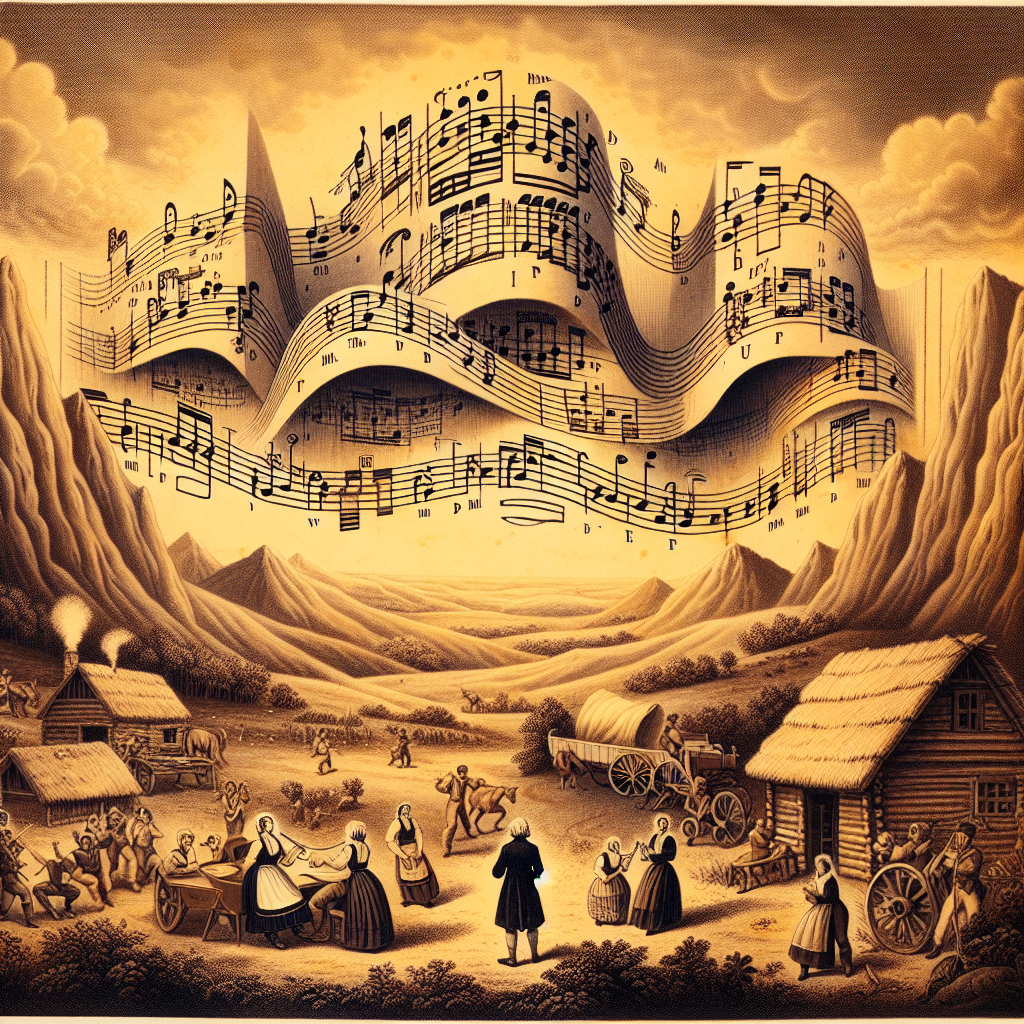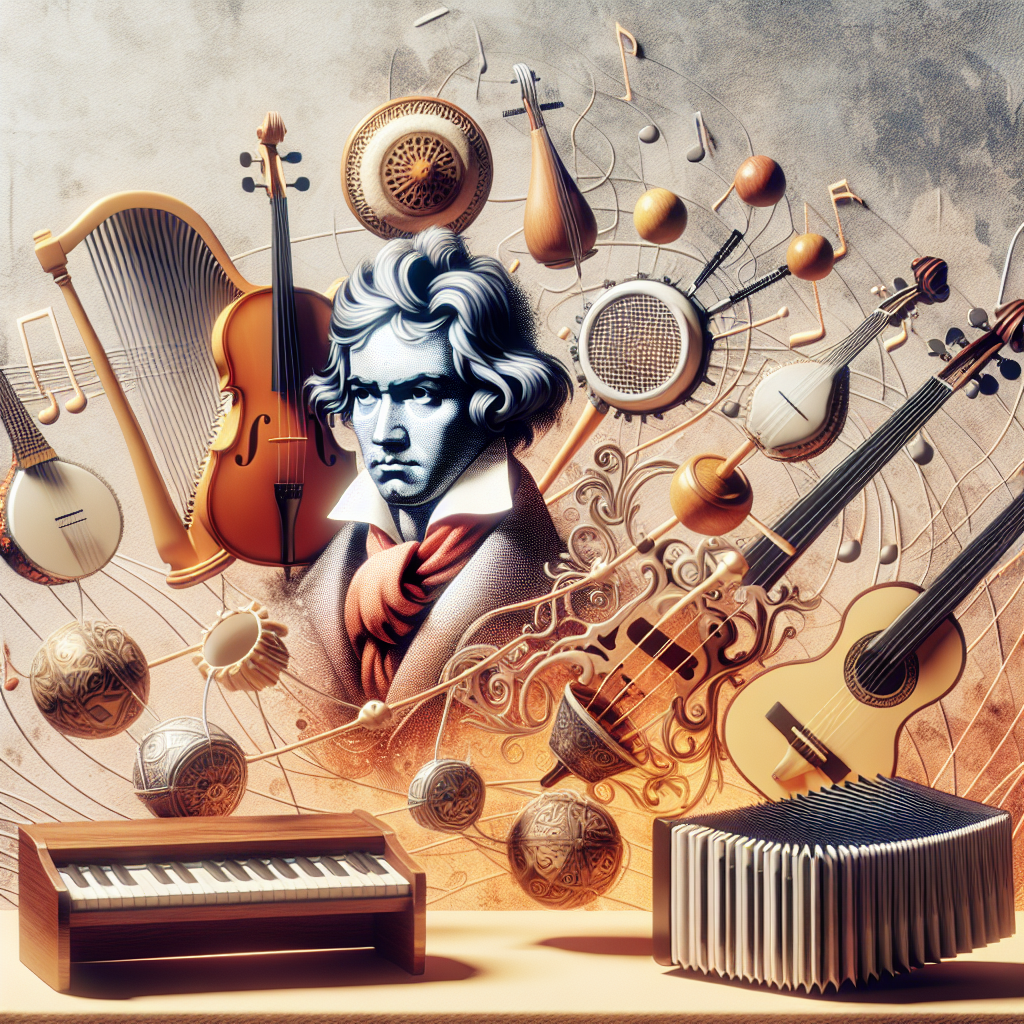
The Role of Folk Music in Shaping Beethoven’s Compositions
Ludwig van Beethoven, one of the most revered composers in Western music history, possesses a legacy that transcends time. Born in Bonn, Germany, in 1770, Beethoven’s music is celebrated for its emotional depth and innovative uses of harmony and form. His symphonies, sonatas, and quartets stand as testaments to his profound understanding of musical expression. However, amid Beethoven’s sophisticated compositions lies an often-overlooked influence: folk music. Folk melodies and characteristics manifest themselves in various ways throughout Beethoven’s works, providing a unique bridge between formal classical traditions and the rich, cultural tapestry of the common people.
The early years of Beethoven’s life were steeped in an environment where folk music naturally permeated daily life. Whether through public performances, family gatherings, or local celebrations, the sounds of folk music were ubiquitous. These folk elements imbued his compositions with a sense of universality, making his work relatable to a broad audience beyond the courtly elite. Beethoven’s connection to folk music showcases the seamless integration of these melodies into his symphonies and sonatas, subtly enriching the fabric of his compositions.
This article delves into the various ways folk music influenced Beethoven’s compositions and examines how his contemporaries and the cultural milieu of his time contributed to this integration. In doing so, it provides a nuanced understanding of the multi-faceted inspirations that underpinned Beethoven’s creative output. Join us as we explore Beethoven’s life, his engagement with folk music, and the role this union played in his timeless masterpieces.
Beethoven’s Early Life and Exposure to Folk Music
The early life of Ludwig van Beethoven was marked by both musical nurturing and emotional turbulence. Born into a musical family, his father Johann van Beethoven, recognized his prodigious talents at a young age and sought to cultivate them rigorously. However, beyond the formal music lessons, Beethoven was surrounded by the sounds of everyday folk music. Bonn, where Beethoven spent his early years, was a city buzzing with musical activity; taverns, homes, and streets resounded with melodies that were an intrinsic part of local culture.
In the rural and semi-urban areas of 18th-century Germany, folk music was an essential component of both celebration and daily life. Tunes were passed down through generations, often evolving with each iteration, yet retaining a distinct cultural essence. These melodies had a simplicity and charm that contrasted with the more structured court and liturgical music prevalent at the time.
As a young musician, Beethoven was naturally receptive to these varied musical influences. The lively hum of folk tunes actively shaped his auditory world. This exposure was not just passive listening; it involved active participation in communal music-making, thereby ingraining folk musical elements into his subconscious. Folk songs presented a stark emotional purity that Beethoven would draw upon throughout his career, as he continually sought to connect the high art of classical music with the universal language of folk traditions.
These experiences embedded within Beethoven a rich tapestry of folk melodies and rhythms, which later manifested in his work in numerous subtle and not-so-subtle ways. As he matured, his ability to blend these folk elements with classical forms became one of the hallmarks of his genius, earning him a unique place in the annals of music history.
The Integration of Folk Elements in Beethoven’s Music
Beethoven’s masterful integration of folk music into his compositions can be observed in multiple works, illustrating his profound appreciation and understanding of the genre. His use of folk elements was not mere mimicry or quotation; it was an intricate weaving of these elements into the fabric of his more sophisticated compositions.
One prominent example is the “Pastoral Symphony” (Symphony No. 6). This symphony is an evocative representation of rural life, filled with scenes that one might associate with the countryside. The symphony’s second movement, “Scene by the Brook,” mimics the gentle flow of water and the murmuring of birds in a way that conjures the essence of folk music’s simplicity and emotive power.
In addition, Beethoven’s setting of songs, like those in the “Irish Songs” and “Scottish Songs,” provide another clear intersection with folk music. These arrangements reveal his keen interest in the music of the people, translating it into his style. He took traditional tunes from these cultures and set them with imaginative and intricate piano accompaniments, blending the two worlds of folk and classical music artfully, thereby broadening the reach of these folk songs within the concert repertoire.
Moreover, the inclusion of dances like the Ländler and the German traditional dance in his compositions served to reinforce his connection to folk traditions. For instance, in many of his symphonies and chamber works, Beethoven invokes dance rhythms that are inherently tied to the folk music of his homeland, giving them a universal appeal. The Ländler, a folk dance in triple meter, often appears in his scherzos, infusing his compositions with a lively and rhythmic character that resonates with the vitality of folk traditions.

Contemporaries and Their Influence
During Beethoven’s time, he was by no means alone in integrating folk music into his works. This practice was common among several of his contemporaries, both influencing him and being influenced by him. Joseph Haydn and Franz Schubert are two notable figures in this regard.
Joseph Haydn, often lauded as the “Father of the Symphony,” had an earlier and more pronounced engagement with folk music, particularly due to his rural upbringing. Haydn’s incorporation of folk elements in his symphonies and string quartets, characterized by robust rhythms and rustic melodies, laid the groundwork for a form of music deeply connected to popular culture. Beethoven, who studied composition with Haydn, was undoubtedly influenced by such traits. This connection reinforced Beethoven’s inclination to merge folk elements with classical forms.
Franz Schubert, who was slightly younger than Beethoven, also had a profound interest in folk music. Schubert’s Lieder were often based on folk themes, and his use of folk dance rhythms and melodies in his piano works and symphonies demonstrates a clear parallel with Beethoven’s stylistic choices. The mutual admiration between Beethoven and Schubert, with both composers attending each other’s performances, indicates a significant exchange of ideas and influences.
Moreover, the broader Romantic movement, which began to take shape during Beethoven’s later years, celebrated the individual and the common people, making folk music an essential element of artistic expression. Composers like Carl Maria von Weber and Felix Mendelssohn further propagated the inclusion of folk elements, creating a fertile ground that nourished Beethoven’s interests.
These contemporaries, along with the cultural milieu that endorsed an appreciation for folk traditions, played a critical role in shaping Beethoven’s approach to integrating folk music into his classical compositions. The synergy between Beethoven and his contemporaries underscores a collective movement towards creating a music ethos that bridged social and cultural divides.
Beethoven’s Stylistic Evolution and Folk Music
Beethoven’s stylistic evolution over his career also reflects a deepening relationship with folk music. His early works were more closely aligned with the Classical style prevalent at the time; however, as he matured, his compositions began to reflect a more extensive and innovative use of folk material.
In his middle period, characterized by works such as the “Eroica Symphony” and the “Appassionata Sonata,” Beethoven’s music took on a grander scale and emotional drama. Despite the complexity and grandeur of these compositions, there is an evident infusion of folk-like simplicity and directness. For example, the second movement of the “Eroica Symphony” contains elements reminiscent of a funeral march, which bears a stark, almost folky simplicity at its heart.
Beethoven’s late works, particularly his late string quartets and the “Ninth Symphony,” demonstrate an era of fearless innovation. His String Quartet No. 13, with its “Grosse Fuge” finale, pushes the boundaries of form and harmony. Yet, nestled within this avant-garde complexity are transparent moments of folk charm, as seen in the lighthearted “Alla danza tedesca” movement, which references the German dance tradition.
The “Ninth Symphony” encapsulates Beethoven’s synthesis of folk elements with classical form. The famous “Ode to Joy” melody, simple and folk-like in nature, serves as the central theme around which Beethoven constructs the final movement’s sprawling, celebratory structure. This movement exemplifies how Beethoven used a straightforward, memorable melody to capture a universal spirit, making a powerful statement about unity and brotherhood.
Thus, the evolution of Beethoven’s style, particularly his increasing inclusion of folk elements, encapsulates his broader artistic journey. This seamless amalgamation of the sophisticated and the folkish reflects his enduring quest to create music that spoke to all layers of society, affirming his place as a truly universal composer.
Impact of Beethoven’s Integration of Folk Music on Future Composers
Beethoven’s success in integrating folk elements into his compositions laid a fertile foundation for future composers. His innovative approach resonated through the 19th and 20th centuries, influencing a wide array of musicians across genres and geographic boundaries.
Johannes Brahms, a composer who frequently revered Beethoven, drew unapologetically from folk traditions. His “Hungarian Dances” are one of the best examples, illustrating an elaborate treatment of folk melodies within the framework of classical music. Brahms’ symphonies and chamber works often feature folk-inspired rhythmic patterns and melodies, demonstrating how effectively this approach can harness emotional depth and accessibility.
Antonín Dvořák, another prominent composer influenced by Beethoven, emphasized his nationalistic tendencies by integrating Czech folk music into his symphonies, operas, and chamber works. Dvořák’s “New World Symphony,” for instance, showcases themes inspired by Native American music and African American spirituals, revealing the far-reaching impact of Beethoven’s folk-inspired innovations.
In the 20th century, composers like Béla Bartók and Igor Stravinsky continued this tradition in a more modernistic context. Bartók’s exhaustive collection of Eastern European folk music and its subsequent integration into his compositions are direct descendents of Beethoven’s practice. Similarly, Stravinsky’s early ballets, such as “The Firebird” and “Petrushka,” draw heavily on Russian folk tunes.
Beethoven’s approach to folk music not only broadened the artistic horizons of classical music but also contributed to the broader acceptance of vernacular music within professional music circles. This change in perception allowed composers of various nationalities and styles to confidently draw upon their folk traditions, enriching the global musical landscape. Beethoven’s pioneering spirit and his successful integration of folk music resonated across periods and styles, impacting composers from the Romantic era to modernism and beyond.
Conclusion
Ludwig van Beethoven’s legacy in the realm of classical music is undisputed, and his integration of folk music into his compositions is a testament to his innovative spirit and deep understanding of universal themes. From the early influences in his Bonn upbringing to his matured and stylistically diverse works, folk music remained a continuous thread in his musical fabric. Through his adept incorporation of folk melodies and rhythms, Beethoven bridged the gap between the sophisticated structures of classical music and the heartfelt simplicity of folk traditions, creating compositions that resounded with profound emotional and cultural significance.
Moreover, Beethoven’s influence on his contemporaries and subsequent generations of composers underscored the lasting impact of his folk-inspired innovations. His methods provided a valuable template for future musicians, allowing them to explore and celebrate their native musical traditions within classical frameworks. This fusion enriched the musical diversity of the 19th and 20th centuries, leading to a rich tapestry of compositions that continue to captivate audiences worldwide.
In recognizing the role of folk music in shaping Beethoven’s compositions, we gain a deeper appreciation of his work and its timeless appeal. Beethoven’s genius lay not just in his technical prowess but also in his ability to communicate deeply human emotions and experiences through his music. His engagement with folk music enabled him to transcend cultural and social barriers, crafting a universal language that still speaks to the hearts and minds of listeners today. Ultimately, Beethoven’s legacy as a composer is intertwined with his brilliant ability to merge the folk traditions with the classical, underscoring his unique place in the pantheon of musical greats.